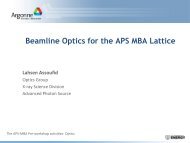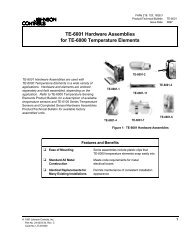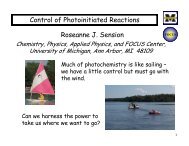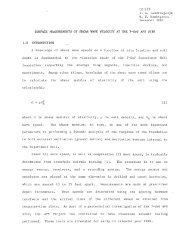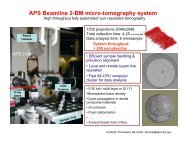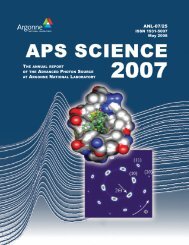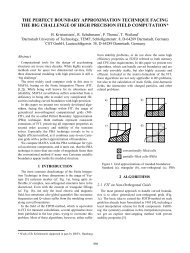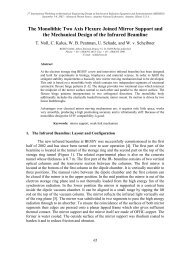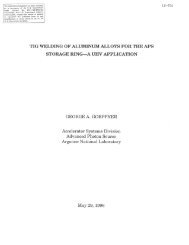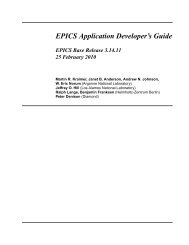Mechanical Design, Construction and Alignment of the ISAC RFQ ...
Mechanical Design, Construction and Alignment of the ISAC RFQ ...
Mechanical Design, Construction and Alignment of the ISAC RFQ ...
Create successful ePaper yourself
Turn your PDF publications into a flip-book with our unique Google optimized e-Paper software.
dinal growth <strong>of</strong> 2.0 mm. The elasticity <strong>of</strong> <strong>the</strong> mounting<br />
system copes with this <strong>and</strong> growth returns to zero at operating<br />
temperature.<br />
3 ACCELERATOR COMPONENTS<br />
3.1 <strong>Design</strong> Considerations<br />
Each ring is identical <strong>and</strong> consists <strong>of</strong> a base, a stem, a split<br />
strong back, two electrode supports <strong>and</strong> an rf skin (Fig. 1).<br />
To achieve <strong>the</strong>rmal stability all rf surfaces are water cooled<br />
(except for <strong>the</strong> outer rf skin). This is done by using two separate<br />
water circuits. Circuit 1 supplies cooling water from<br />
<strong>the</strong> inlet manifold to a tube array soldered on <strong>the</strong> inside <strong>of</strong><br />
<strong>the</strong> inner rf skin; from <strong>the</strong>re <strong>the</strong> water enters a circuit drilled<br />
into <strong>the</strong> electrode support (Fig. 2) <strong>and</strong> <strong>the</strong>n returns to <strong>the</strong><br />
outer manifold. Circuit 2 transports water from <strong>the</strong> inlet<br />
manifold to <strong>the</strong> electrode supports through <strong>the</strong> electrodes to<br />
<strong>the</strong> adjacent ring. Hence, with a 3-ring platen, number 2ring<br />
supplies water to <strong>the</strong> 4 electrodes, <strong>and</strong> number 1 <strong>and</strong> 3<br />
rings receive <strong>and</strong> return <strong>the</strong> water. The rf skin encloses <strong>the</strong><br />
strong back but is attached only where it meets <strong>the</strong> electrode<br />
supports, thus allowing for <strong>the</strong>rmal growth <strong>of</strong> <strong>the</strong> skin without<br />
loading <strong>the</strong> structure <strong>and</strong> causing electrode misalignment.<br />
Prototype tests indicate a very small movement during<br />
voltage ramp-up but this returns to zero at steady state.<br />
Tests on <strong>the</strong> seven rings showed no movement at all.<br />
As mentioned <strong>the</strong> philosophy <strong>of</strong> mechanical positioning,<br />
or alignment <strong>of</strong> <strong>the</strong> rings, in order to control <strong>the</strong> accuracy <strong>of</strong><br />
<strong>the</strong> electrodes around a true datum line in space (i.e., beam<br />
centerline), is to make each ring identical such that when<br />
sitting in a jig on its baseplate <strong>the</strong> electrode mounting pads<br />
are within 25 m, <strong>of</strong> true position. In <strong>the</strong> tank <strong>the</strong>re are 6<br />
platens – <strong>the</strong> first supports 4 rings, <strong>and</strong> <strong>the</strong> remaining five 3<br />
rings each. Each platen consists <strong>of</strong> a special steel 63.5 mm<br />
thick with an <strong>of</strong>fset longitudinal rail bolted <strong>and</strong> doweled in<br />
place. The platen <strong>and</strong> rail are accurately ground in one set<br />
up, thus providing accurate datums for mounting <strong>and</strong> locating<br />
<strong>the</strong> ring bases (<strong>the</strong> flatness tolerances, i.e., 12 m).<br />
The platens have 5 adjustable mounting points - 3 vertical<br />
Figure 2: Electrode support showing holes drilled for water<br />
cooling circuits.<br />
981<br />
<strong>and</strong> 2 lateral. Each platen is adjusted in <strong>the</strong> tank using special<br />
targets for each platen <strong>and</strong> aligned by <strong>the</strong> <strong>the</strong>odolite<br />
intersection procedure which is covered in a later section.<br />
Once <strong>the</strong> platens are aligned <strong>the</strong>y are locked in position <strong>and</strong><br />
are ready for installation <strong>of</strong> <strong>the</strong> rings.<br />
3.2 Fabrication Considerations<br />
In order to achieve <strong>the</strong> manufacture <strong>of</strong> identical rings a<br />
philosophy <strong>of</strong> fabrication <strong>and</strong> assembly had to be decided<br />
upon. The key to this is that <strong>the</strong> mounting surface on which<br />
<strong>the</strong> vane shaped electrodes are mounted are machined as <strong>the</strong><br />
last major operation. In order to achieve this with such an<br />
awkward shape it was decided to use Electrical Discharge<br />
Machining (EDM) <strong>and</strong> employ a master fixture that would<br />
engage datum features on <strong>the</strong> ring base (<strong>the</strong> same features<br />
that would eventually engage <strong>the</strong> datums on <strong>the</strong> platen) <strong>and</strong><br />
accurately hold <strong>the</strong> ring in <strong>the</strong> EDM machine for final machining,<br />
thus ensuring that all rings are machined in an identical<br />
set up. This master fixture also had provision for addition<br />
<strong>of</strong> inspection tooling to check <strong>the</strong> result. The same<br />
fixture was also used to manufacture special targets previously<br />
mentioned which are used to align <strong>the</strong> platens. Finally,<br />
each ring is inspected by an independent organization<br />
using a coordinate measuring system. This method <strong>of</strong> ring<br />
manufacture means that individual components can be held<br />
to reasonable tolerances with enough machine allowance on<br />
<strong>the</strong> electrode platform to accommodate <strong>the</strong> accumulated assembly<br />
tolerances. Prior to EDM machining at final assembly,<br />
all components are doweled toge<strong>the</strong>r <strong>and</strong> cleaned.<br />
The electrode support is also <strong>of</strong> some complexity due to<br />
<strong>the</strong> cooling circuits drilled within <strong>the</strong> shape <strong>of</strong> this component<br />
(see Fig. 2). This is a fully NC machined component<br />
produced to a better than 0.80 m surface finish in<br />
chromium copper (tellurium copper was chosen due to a<br />
higher machinability <strong>and</strong> conductivity rating but pieces <strong>of</strong><br />
this size are unavailable).<br />
The only o<strong>the</strong>r components that require special mention<br />
are <strong>the</strong> electrodes <strong>and</strong> <strong>the</strong> rf skin. The electrodes are <br />
13 mm x 38 mm x 120 cm long (except <strong>the</strong> first two sets<br />
which are 80 cm long) <strong>and</strong> made from tellurium copper for<br />
improved machinability <strong>and</strong> good conductivity. The rods<br />
are rough machined, gun drilled for water cooling channels<br />
<strong>and</strong> straightened by <strong>the</strong> supplier. The cooling holes are<br />
plugged at ei<strong>the</strong>r end with silver soldered plugs. They are<br />
<strong>the</strong>n finally machined <strong>and</strong> pr<strong>of</strong>ile cut on an NC machine to<br />
an overall tolerance <strong>of</strong> 25 m. Both <strong>the</strong> electrode <strong>and</strong><br />
electrode support quality <strong>and</strong> accuracy met or exceeded our<br />
expectations.<br />
The rf skin is made from 2.2 mm thick C110 copper <strong>and</strong><br />
<strong>the</strong> u-shaped ring was created by spinning over a m<strong>and</strong>rel<br />
in two pieces that were later brazed toge<strong>the</strong>r. Mounting<br />
frames <strong>and</strong> flanges are soldered <strong>and</strong> finished machined <strong>and</strong><br />
<strong>the</strong> cooling array is <strong>the</strong>n soldered in position.



